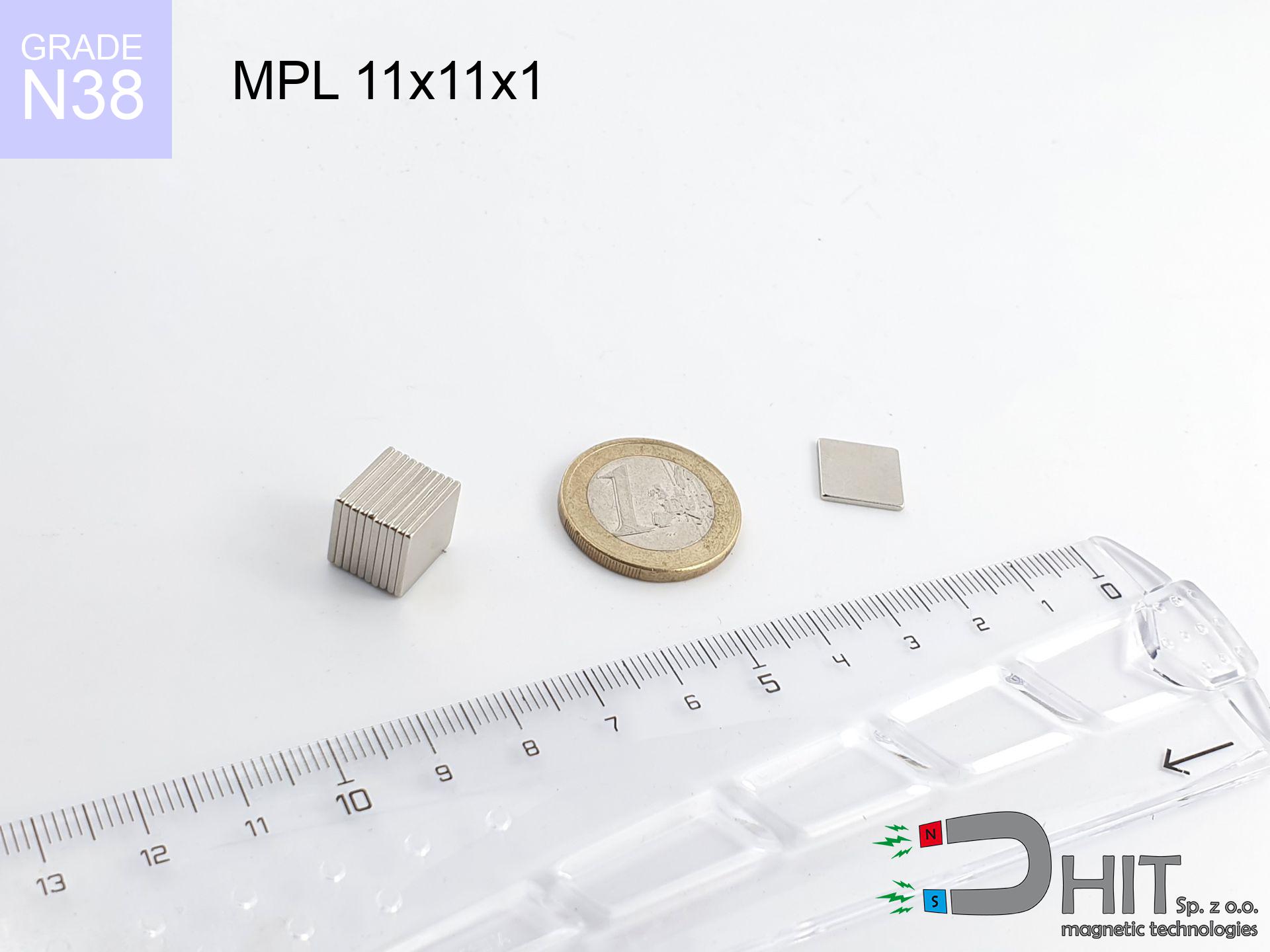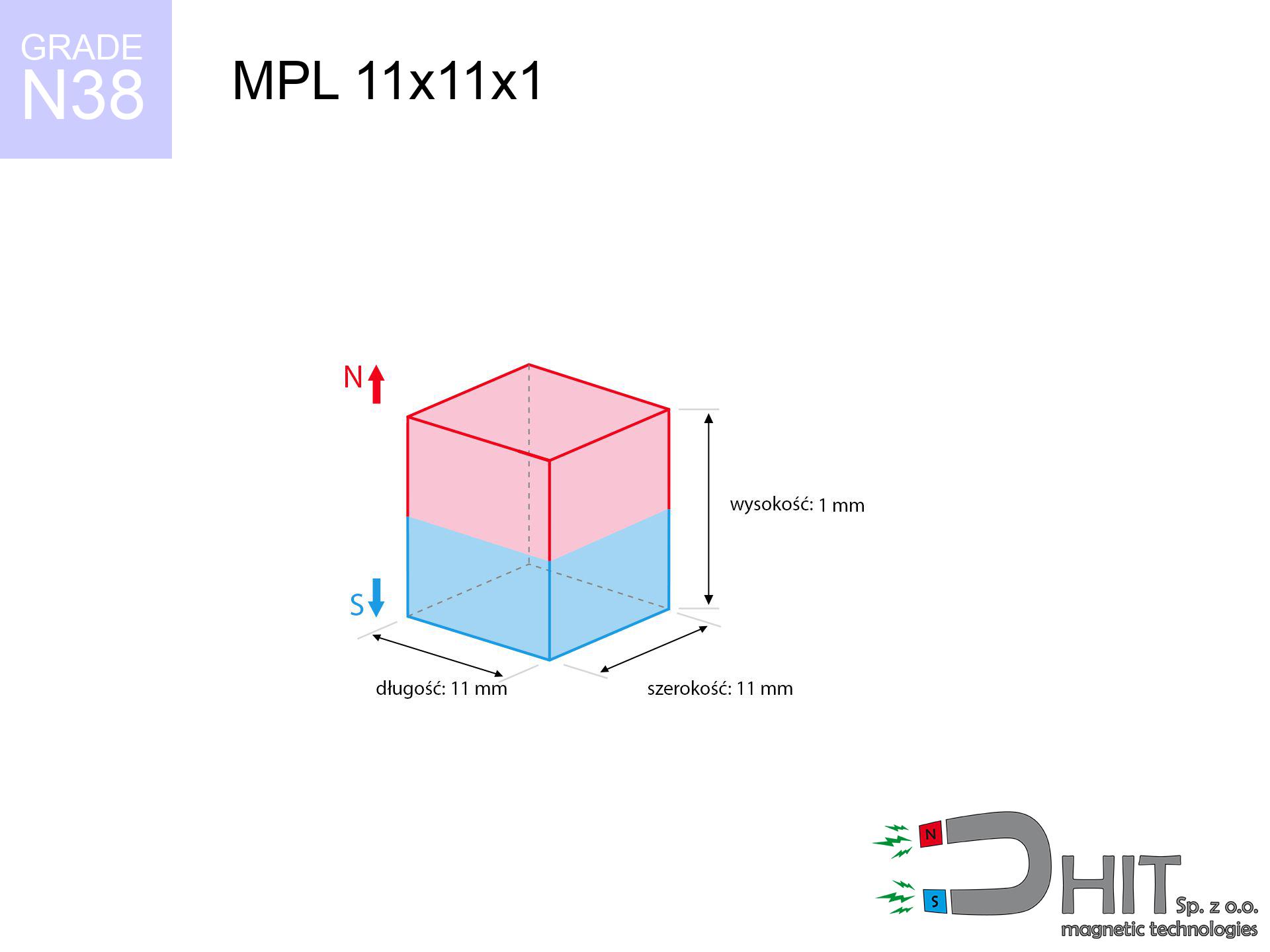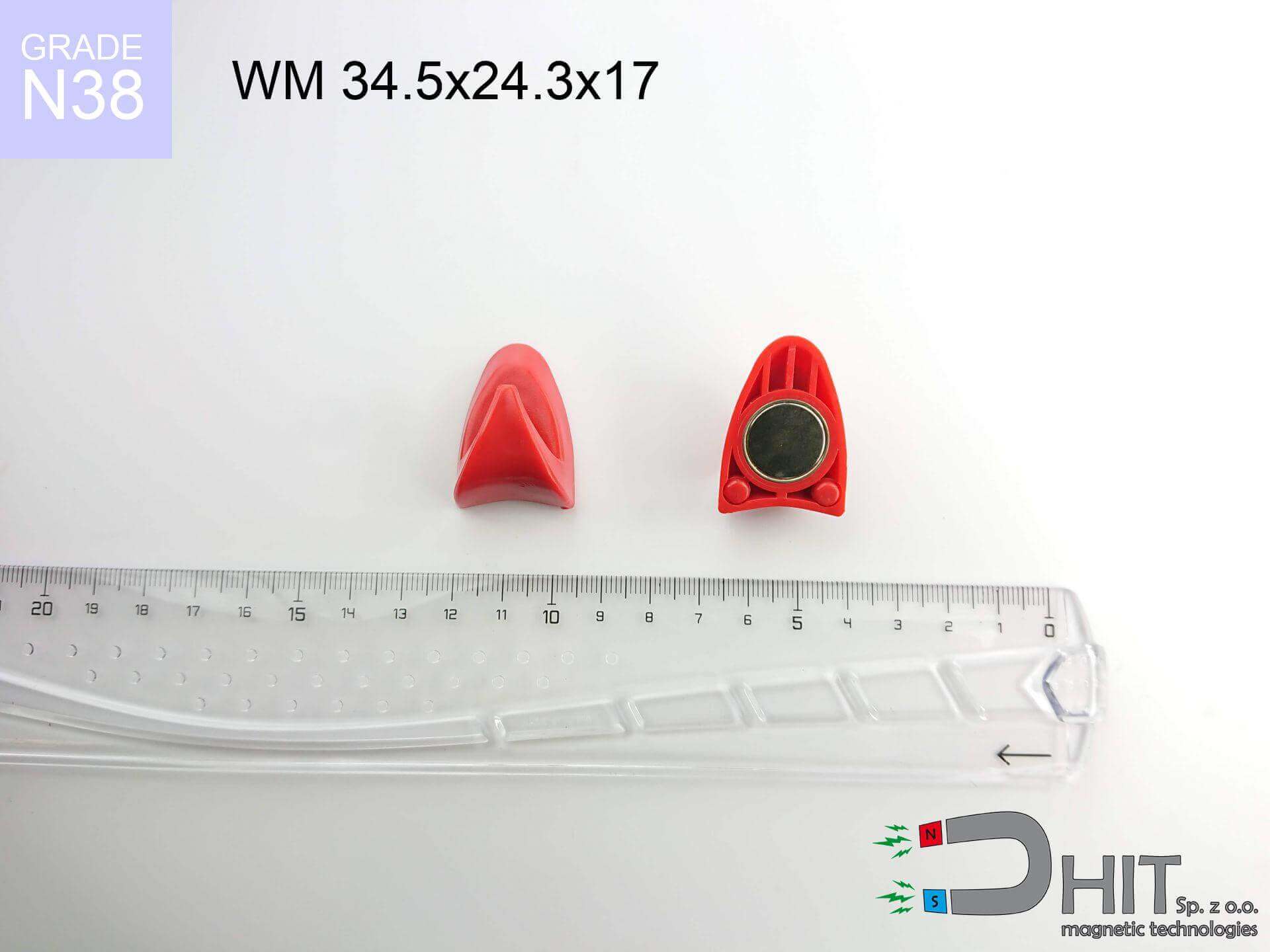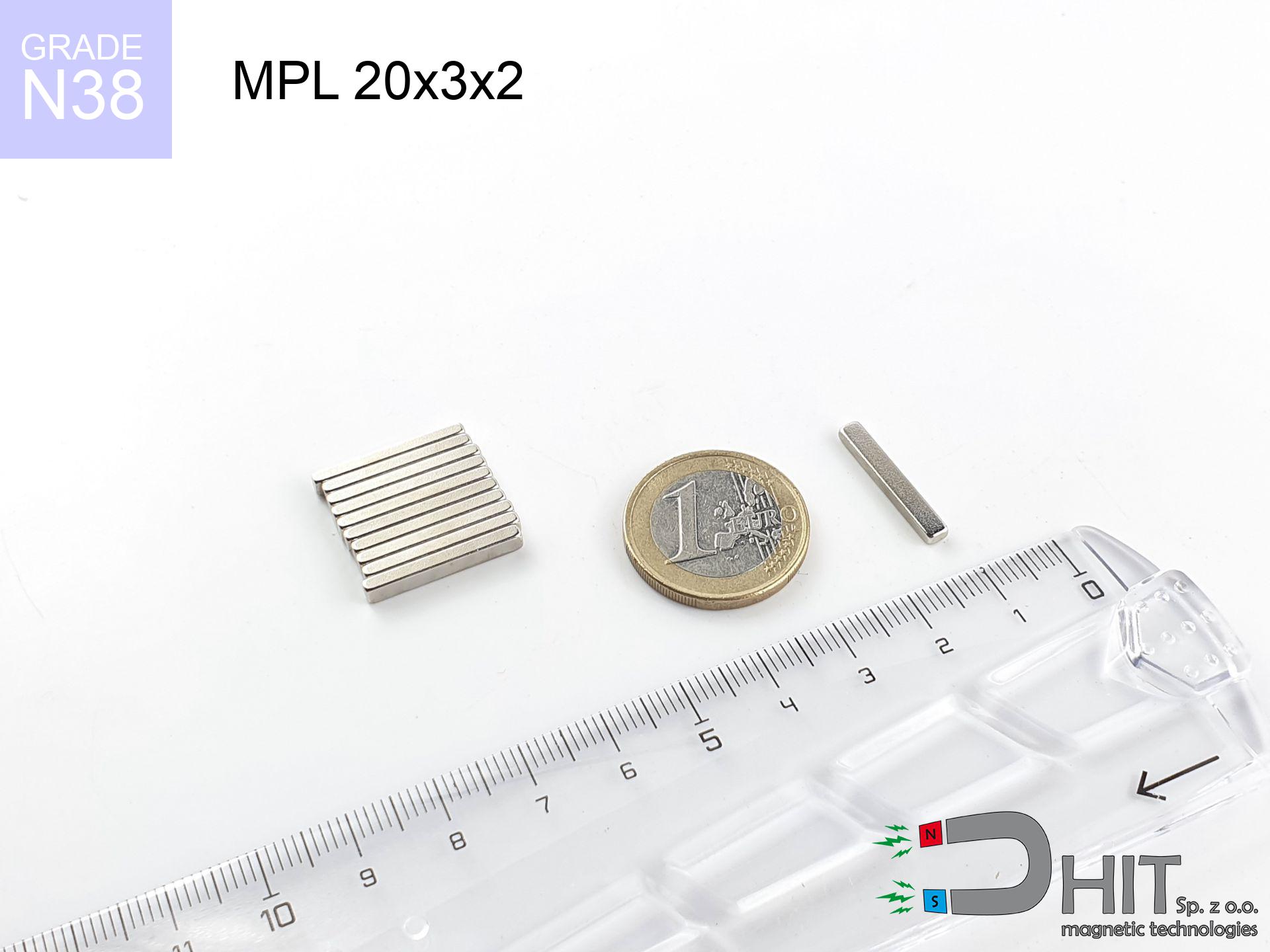MPL 11x11x1 / N38 - lamellar magnet
lamellar magnet
Catalog no 020116
GTIN/EAN: 5906301811220
length
11 mm [±0,1 mm]
Width
11 mm [±0,1 mm]
Height
1 mm [±0,1 mm]
Weight
0.91 g
Magnetization Direction
↑ axial
Load capacity
0.43 kg / 4.24 N
Magnetic Induction
100.10 mT / 1001 Gs
Coating
[NiCuNi] Nickel
0.873 ZŁ with VAT / pcs + price for transport
0.710 ZŁ net + 23% VAT / pcs
bulk discounts:
Need more?Hunting for a discount?
Pick up the phone and ask
+48 888 99 98 98
if you prefer get in touch via
request form
the contact section.
Force and appearance of magnetic components can be verified using our
modular calculator.
Same-day shipping for orders placed before 14:00.
MPL 11x11x1 / N38 - lamellar magnet
Specification / characteristics MPL 11x11x1 / N38 - lamellar magnet
| properties | values |
|---|---|
| Cat. no. | 020116 |
| GTIN/EAN | 5906301811220 |
| Production/Distribution | Dhit sp. z o.o. |
| Country of origin | Poland / China / Germany |
| Customs code | 85059029 |
| length | 11 mm [±0,1 mm] |
| Width | 11 mm [±0,1 mm] |
| Height | 1 mm [±0,1 mm] |
| Weight | 0.91 g |
| Magnetization Direction | ↑ axial |
| Load capacity ~ ? | 0.43 kg / 4.24 N |
| Magnetic Induction ~ ? | 100.10 mT / 1001 Gs |
| Coating | [NiCuNi] Nickel |
| Manufacturing Tolerance | ±0.1 mm |
Magnetic properties of material N38
| properties | values | units |
|---|---|---|
| remenance Br [min. - max.] ? | 12.2-12.6 | kGs |
| remenance Br [min. - max.] ? | 1220-1260 | mT |
| coercivity bHc ? | 10.8-11.5 | kOe |
| coercivity bHc ? | 860-915 | kA/m |
| actual internal force iHc | ≥ 12 | kOe |
| actual internal force iHc | ≥ 955 | kA/m |
| energy density [min. - max.] ? | 36-38 | BH max MGOe |
| energy density [min. - max.] ? | 287-303 | BH max KJ/m |
| max. temperature ? | ≤ 80 | °C |
Physical properties of sintered neodymium magnets Nd2Fe14B at 20°C
| properties | values | units |
|---|---|---|
| Vickers hardness | ≥550 | Hv |
| Density | ≥7.4 | g/cm3 |
| Curie Temperature TC | 312 - 380 | °C |
| Curie Temperature TF | 593 - 716 | °F |
| Specific resistance | 150 | μΩ⋅cm |
| Bending strength | 250 | MPa |
| Compressive strength | 1000~1100 | MPa |
| Thermal expansion parallel (∥) to orientation (M) | (3-4) x 10-6 | °C-1 |
| Thermal expansion perpendicular (⊥) to orientation (M) | -(1-3) x 10-6 | °C-1 |
| Young's modulus | 1.7 x 104 | kg/mm² |
Physical analysis of the product - data
Presented information are the outcome of a engineering calculation. Results rely on algorithms for the material Nd2Fe14B. Actual conditions may differ. Use these data as a reference point when designing systems.
MPL 11x11x1 / N38
| Distance (mm) | Induction (Gauss) / mT | Pull Force (kg) | Risk Status |
|---|---|---|---|
| 0 mm |
1001 Gs
100.1 mT
|
0.43 kg / 430.0 g
4.2 N
|
safe |
| 1 mm |
925 Gs
92.5 mT
|
0.37 kg / 367.7 g
3.6 N
|
safe |
| 2 mm |
800 Gs
80.0 mT
|
0.27 kg / 274.9 g
2.7 N
|
safe |
| 3 mm |
659 Gs
65.9 mT
|
0.19 kg / 186.5 g
1.8 N
|
safe |
| 5 mm |
415 Gs
41.5 mT
|
0.07 kg / 74.0 g
0.7 N
|
safe |
| 10 mm |
130 Gs
13.0 mT
|
0.01 kg / 7.3 g
0.1 N
|
safe |
| 15 mm |
51 Gs
5.1 mT
|
0.00 kg / 1.1 g
0.0 N
|
safe |
| 20 mm |
24 Gs
2.4 mT
|
0.00 kg / 0.3 g
0.0 N
|
safe |
| 30 mm |
8 Gs
0.8 mT
|
0.00 kg / 0.0 g
0.0 N
|
safe |
| 50 mm |
2 Gs
0.2 mT
|
0.00 kg / 0.0 g
0.0 N
|
safe |
MPL 11x11x1 / N38
| Distance (mm) | Friction coefficient | Pull Force (kg) |
|---|---|---|
| 0 mm | Stal (~0.2) |
0.09 kg / 86.0 g
0.8 N
|
| 1 mm | Stal (~0.2) |
0.07 kg / 74.0 g
0.7 N
|
| 2 mm | Stal (~0.2) |
0.05 kg / 54.0 g
0.5 N
|
| 3 mm | Stal (~0.2) |
0.04 kg / 38.0 g
0.4 N
|
| 5 mm | Stal (~0.2) |
0.01 kg / 14.0 g
0.1 N
|
| 10 mm | Stal (~0.2) |
0.00 kg / 2.0 g
0.0 N
|
| 15 mm | Stal (~0.2) |
0.00 kg / 0.0 g
0.0 N
|
| 20 mm | Stal (~0.2) |
0.00 kg / 0.0 g
0.0 N
|
| 30 mm | Stal (~0.2) |
0.00 kg / 0.0 g
0.0 N
|
| 50 mm | Stal (~0.2) |
0.00 kg / 0.0 g
0.0 N
|
MPL 11x11x1 / N38
| Surface type | Friction coefficient / % Mocy | Max load (kg) |
|---|---|---|
| Raw steel |
µ = 0.3
30% Nominalnej Siły
|
0.13 kg / 129.0 g
1.3 N
|
| Painted steel (standard) |
µ = 0.2
20% Nominalnej Siły
|
0.09 kg / 86.0 g
0.8 N
|
| Oily/slippery steel |
µ = 0.1
10% Nominalnej Siły
|
0.04 kg / 43.0 g
0.4 N
|
| Magnet with anti-slip rubber |
µ = 0.5
50% Nominalnej Siły
|
0.22 kg / 215.0 g
2.1 N
|
MPL 11x11x1 / N38
| Steel thickness (mm) | % power | Real pull force (kg) |
|---|---|---|
| 0.5 mm |
|
0.04 kg / 43.0 g
0.4 N
|
| 1 mm |
|
0.11 kg / 107.5 g
1.1 N
|
| 2 mm |
|
0.22 kg / 215.0 g
2.1 N
|
| 5 mm |
|
0.43 kg / 430.0 g
4.2 N
|
| 10 mm |
|
0.43 kg / 430.0 g
4.2 N
|
MPL 11x11x1 / N38
| Ambient temp. (°C) | Power loss | Remaining pull | Status |
|---|---|---|---|
| 20 °C | 0.0% |
0.43 kg / 430.0 g
4.2 N
|
OK |
| 40 °C | -2.2% |
0.42 kg / 420.5 g
4.1 N
|
OK |
| 60 °C | -4.4% |
0.41 kg / 411.1 g
4.0 N
|
|
| 80 °C | -6.6% |
0.40 kg / 401.6 g
3.9 N
|
|
| 100 °C | -28.8% |
0.31 kg / 306.2 g
3.0 N
|
MPL 11x11x1 / N38
| Gap (mm) | Attraction (kg) (N-S) | Repulsion (kg) (N-N) |
|---|---|---|
| 0 mm |
0.75 kg / 747 g
7.3 N
1 925 Gs
|
N/A |
| 1 mm |
0.70 kg / 704 g
6.9 N
1 943 Gs
|
0.63 kg / 634 g
6.2 N
~0 Gs
|
| 2 mm |
0.64 kg / 639 g
6.3 N
1 851 Gs
|
0.58 kg / 575 g
5.6 N
~0 Gs
|
| 3 mm |
0.56 kg / 560 g
5.5 N
1 734 Gs
|
0.50 kg / 504 g
4.9 N
~0 Gs
|
| 5 mm |
0.40 kg / 397 g
3.9 N
1 460 Gs
|
0.36 kg / 358 g
3.5 N
~0 Gs
|
| 10 mm |
0.13 kg / 129 g
1.3 N
831 Gs
|
0.12 kg / 116 g
1.1 N
~0 Gs
|
| 20 mm |
0.01 kg / 13 g
0.1 N
261 Gs
|
0.01 kg / 11 g
0.1 N
~0 Gs
|
| 50 mm |
0.00 kg / 0 g
0.0 N
26 Gs
|
0.00 kg / 0 g
0.0 N
~0 Gs
|
MPL 11x11x1 / N38
| Object / Device | Limit (Gauss) / mT | Safe distance |
|---|---|---|
| Pacemaker | 5 Gs (0.5 mT) | 4.0 cm |
| Hearing aid | 10 Gs (1.0 mT) | 3.0 cm |
| Timepiece | 20 Gs (2.0 mT) | 2.5 cm |
| Mobile device | 40 Gs (4.0 mT) | 2.0 cm |
| Car key | 50 Gs (5.0 mT) | 2.0 cm |
| Payment card | 400 Gs (40.0 mT) | 1.0 cm |
| HDD hard drive | 600 Gs (60.0 mT) | 0.5 cm |
MPL 11x11x1 / N38
| Start from (mm) | Speed (km/h) | Energy (J) | Predicted outcome |
|---|---|---|---|
| 10 mm |
22.15 km/h
(6.15 m/s)
|
0.02 J | |
| 30 mm |
37.97 km/h
(10.55 m/s)
|
0.05 J | |
| 50 mm |
49.02 km/h
(13.62 m/s)
|
0.08 J | |
| 100 mm |
69.33 km/h
(19.26 m/s)
|
0.17 J |
MPL 11x11x1 / N38
| Technical parameter | Value / Description |
|---|---|
| Coating type | [NiCuNi] Nickel |
| Layer structure | Nickel - Copper - Nickel |
| Layer thickness | 10-20 µm |
| Salt spray test (SST) ? | 24 h |
| Recommended environment | Indoors only (dry) |
MPL 11x11x1 / N38
| Parameter | Value | SI Unit / Description |
|---|---|---|
| Magnetic Flux | 1 627 Mx | 16.3 µWb |
| Pc Coefficient | 0.13 | Low (Flat) |
MPL 11x11x1 / N38
| Environment | Effective steel pull | Effect |
|---|---|---|
| Air (land) | 0.43 kg | Standard |
| Water (riverbed) |
0.49 kg
(+0.06 kg Buoyancy gain)
|
+14.5% |
1. Vertical hold
*Warning: On a vertical wall, the magnet holds only ~20% of its max power.
2. Steel saturation
*Thin steel (e.g. 0.5mm PC case) severely reduces the holding force.
3. Temperature resistance
*For N38 grade, the max working temp is 80°C.
4. Demagnetization curve and operating point (B-H)
chart generated for the permeance coefficient Pc (Permeance Coefficient) = 0.13
The chart above illustrates the magnetic characteristics of the material within the second quadrant of the hysteresis loop. The solid red line represents the demagnetization curve (material potential), while the dashed blue line is the load line based on the magnet's geometry. The Pc (Permeance Coefficient), also known as the load line slope, is a dimensionless value that describes the relationship between the magnet's shape and its magnetic stability. The intersection of these two lines (the black dot) is the operating point — it determines the actual magnetic flux density generated by the magnet in this specific configuration. A higher Pc value means the magnet is more 'slender' (tall relative to its area), resulting in a higher operating point and better resistance to irreversible demagnetization caused by external fields or temperature. A value of 0.42 is relatively low (typical for flat magnets), meaning the operating point is closer to the 'knee' of the curve — caution is advised when operating at temperatures near the maximum limit to avoid strength loss.
Elemental analysis
| iron (Fe) | 64% – 68% |
| neodymium (Nd) | 29% – 32% |
| boron (B) | 1.1% – 1.2% |
| dysprosium (Dy) | 0.5% – 2.0% |
| coating (Ni-Cu-Ni) | < 0.05% |
Environmental data
| recyclability (EoL) | 100% |
| recycled raw materials | ~10% (pre-cons) |
| carbon footprint | low / zredukowany |
| waste code (EWC) | 16 02 16 |
Check out more proposals
Strengths as well as weaknesses of neodymium magnets.
Pros
- Their magnetic field is maintained, and after approximately 10 years it drops only by ~1% (theoretically),
- Magnets very well resist against demagnetization caused by ambient magnetic noise,
- Thanks to the shimmering finish, the coating of nickel, gold, or silver gives an professional appearance,
- The surface of neodymium magnets generates a strong magnetic field – this is one of their assets,
- Due to their durability and thermal resistance, neodymium magnets are capable of operate (depending on the shape) even at high temperatures reaching 230°C or more...
- Thanks to flexibility in constructing and the ability to adapt to specific needs,
- Versatile presence in modern technologies – they serve a role in mass storage devices, electric drive systems, medical devices, as well as other advanced devices.
- Thanks to efficiency per cm³, small magnets offer high operating force, with minimal size,
Weaknesses
- They are fragile upon heavy impacts. To avoid cracks, it is worth protecting magnets in a protective case. Such protection not only protects the magnet but also increases its resistance to damage
- Neodymium magnets demagnetize when exposed to high temperatures. After reaching 80°C, many of them experience permanent drop of strength (a factor is the shape as well as dimensions of the magnet). We offer magnets specially adapted to work at temperatures up to 230°C marked [AH], which are very resistant to heat
- When exposed to humidity, magnets start to rust. For applications outside, it is recommended to use protective magnets, such as magnets in rubber or plastics, which prevent oxidation as well as corrosion.
- Due to limitations in creating nuts and complicated forms in magnets, we propose using a housing - magnetic mount.
- Health risk to health – tiny shards of magnets can be dangerous, in case of ingestion, which gains importance in the context of child health protection. It is also worth noting that tiny parts of these magnets are able to be problematic in diagnostics medical in case of swallowing.
- With large orders the cost of neodymium magnets can be a barrier,
Holding force characteristics
Breakaway strength of the magnet in ideal conditions – what it depends on?
- with the use of a yoke made of special test steel, ensuring full magnetic saturation
- with a cross-section minimum 10 mm
- characterized by smoothness
- without any insulating layer between the magnet and steel
- during detachment in a direction perpendicular to the mounting surface
- in neutral thermal conditions
Lifting capacity in practice – influencing factors
- Gap between surfaces – even a fraction of a millimeter of separation (caused e.g. by varnish or dirt) diminishes the pulling force, often by half at just 0.5 mm.
- Force direction – note that the magnet holds strongest perpendicularly. Under shear forces, the capacity drops significantly, often to levels of 20-30% of the nominal value.
- Metal thickness – the thinner the sheet, the weaker the hold. Magnetic flux penetrates through instead of generating force.
- Metal type – not every steel reacts the same. High carbon content weaken the attraction effect.
- Plate texture – smooth surfaces guarantee perfect abutment, which increases force. Uneven metal reduce efficiency.
- Temperature – heating the magnet causes a temporary drop of induction. Check the thermal limit for a given model.
Holding force was tested on the plate surface of 20 mm thickness, when a perpendicular force was applied, however under attempts to slide the magnet the load capacity is reduced by as much as 75%. In addition, even a minimal clearance between the magnet and the plate reduces the lifting capacity.
Machining danger
Fire warning: Rare earth powder is highly flammable. Avoid machining magnets without safety gear as this may cause fire.
Risk of cracking
NdFeB magnets are ceramic materials, which means they are prone to chipping. Impact of two magnets leads to them breaking into small pieces.
Finger safety
Protect your hands. Two powerful magnets will snap together instantly with a force of massive weight, crushing everything in their path. Exercise extreme caution!
Medical interference
Life threat: Strong magnets can deactivate pacemakers and defibrillators. Stay away if you have medical devices.
Safe distance
Very strong magnetic fields can destroy records on payment cards, hard drives, and storage devices. Maintain a gap of at least 10 cm.
Do not give to children
NdFeB magnets are not suitable for play. Eating multiple magnets can lead to them connecting inside the digestive tract, which constitutes a direct threat to life and necessitates immediate surgery.
Do not underestimate power
Before use, check safety instructions. Uncontrolled attraction can destroy the magnet or injure your hand. Think ahead.
Phone sensors
An intense magnetic field disrupts the operation of compasses in smartphones and GPS navigation. Maintain magnets near a smartphone to avoid damaging the sensors.
Heat warning
Standard neodymium magnets (grade N) lose magnetization when the temperature exceeds 80°C. Damage is permanent.
Metal Allergy
Nickel alert: The nickel-copper-nickel coating contains nickel. If redness appears, cease handling magnets and wear gloves.







![SM 32x325 [2xM8] / N42 - magnetic separator SM 32x325 [2xM8] / N42 - magnetic separator](https://cdn3.dhit.pl/graphics/products/sm-32x325-2xm8-fog.jpg)


